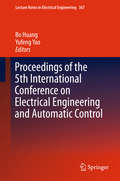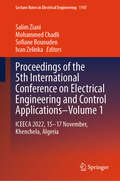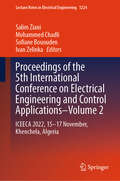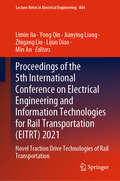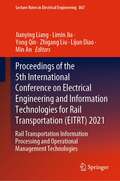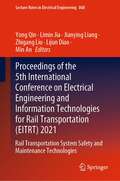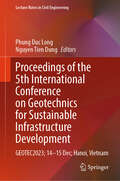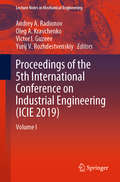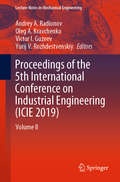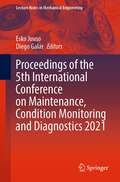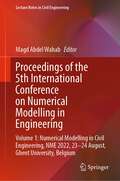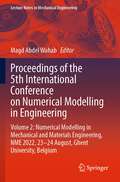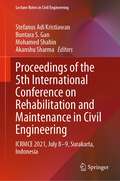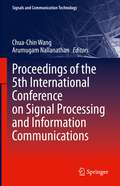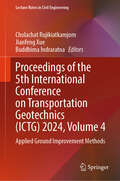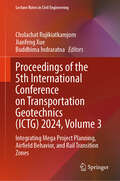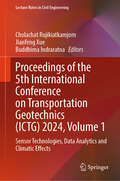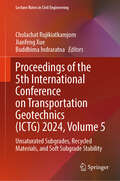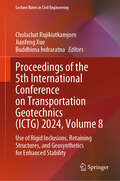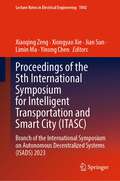- Table View
- List View
Proceedings of the 5th International Conference on Electrical Engineering and Automatic Control
by Bo Huang Yufeng YaoOn the basis of instrument electrical and automatic control system, the 5th International Conference on Electrical Engineering and Automatic Control (CEEAC) was established at the crossroads of information technology and control technology, and seeks to effectively apply information technology to a sweeping trend that views control as the core of intelligent manufacturing and life. This book takes a look forward into advanced manufacturing development, an area shaped by intelligent manufacturing. It highlights the application and promotion of process control represented by traditional industries, such as the steel industry and petrochemical industry; the technical equipment and system cooperative control represented by robot technology and multi-axis CNC; and the control and support of emerging process technologies represented by laser melting and stacking, as well as the emerging industry represented by sustainable and intelligent life. The book places particular emphasis on the micro-segments field, such as intelligent micro-grids, new energy vehicles, and the Internet of Things.
Proceedings of the 5th International Conference on Electrical Engineering and Control Applications–Volume 1: ICEECA 2022, 15–17 November, Khenchela, Algeria (Lecture Notes in Electrical Engineering #1147)
by Ivan Zelinka Mohammed Chadli Sofiane Bououden Salim ZianiThis book gathers papers presented during the 5th International Conference on Electrical Engineering and Control Applications (ICEECA 2022), held on November, 15–17, 2022, Khenchela, Algeria. It covers new control system models, troubleshooting tips, and complex system requirements, such as increased speed, precision, and remote capabilities. Additionally, the book discusses not only the engineering aspects of signal processing and various practical issues in the broad field of information transmission, but also novel technologies for communication networks and modern antenna design. The later part of the book covers important related topics such as fault diagnosis and fault-tolerant control strategies for nonlinear systems and alternative energy sources. This book is intended for researchers, engineers, and advanced postgraduate students in the fields of control and electrical engineering, computer science, signal processing, as well as mechanical and chemical engineering.
Proceedings of the 5th International Conference on Electrical Engineering and Control Applications–Volume 2: ICEECA 2022, 15–17 November, Khenchela, Algeria (Lecture Notes in Electrical Engineering #1224)
by Ivan Zelinka Mohammed Chadli Sofiane Bououden Salim ZianiThis book gathers papers presented during the 5th International Conference on Electrical Engineering and Control Applications (ICEECA 2022), held on November, 15–17, 2022, Khenchela, Algeria. It covers new control system models, troubleshooting tips, and complex system requirements, such as increased speed, precision, and remote capabilities. Additionally, the book discusses not only the engineering aspects of signal processing and various practical issues in the broad field of information transmission, but also novel technologies for communication networks and modern antenna design. The later part of the book covers important related topics such as fault diagnosis and fault-tolerant control strategies for nonlinear systems and alternative energy sources. This book is intended for researchers, engineers, and advanced postgraduate students in the fields of control and electrical engineering, computer science, signal processing, as well as mechanical and chemical engineering.
Proceedings of the 5th International Conference on Electrical Engineering and Information Technologies for Rail Transportation: Novel Traction Drive Technologies of Rail Transportation (Lecture Notes in Electrical Engineering #864)
by Zhigang Liu Limin Jia Yong Qin Lijun Diao Min An Jianying LiangThis book reflects the latest research trends, methods and experimental results in the field of electrical and information technologies for rail transportation, which covers abundant state-of-the-art research theories and ideas. As a vital field of research that is highly relevant to current developments in a number of technological domains, the subjects it covered include intelligent computing, information processing, communication technology, automatic control, etc. The objective of the proceedings is to provide a major interdisciplinary forum for researchers, engineers, academicians and industrial professionals to present the most innovative research and development in the field of rail transportation electrical and information technologies. Engineers and researchers in academia, industry and government will also explore an insightful view of the solutions that combine ideas from multiple disciplines in this field. The volumes serve as an excellent reference work for researchers and graduate students working on rail transportation and electrical and information technologies.
Proceedings of the 5th International Conference on Electrical Engineering and Information Technologies for Rail Transportation: Rail Transportation Information Processing and Operational Management Technologies (Lecture Notes in Electrical Engineering #867)
by Zhigang Liu Limin Jia Yong Qin Lijun Diao Min An Jianying LiangThis book reflects the latest research trends, methods, and experimental results in the field of electrical and information technologies for rail transportation, which covers abundant state-of-the-art research theories and ideas. As a vital field of research that is highly relevant to current developments in a number of technological domains, the subjects it covered include intelligent computing, information processing, communication technology, automatic control, etc. The objective of the proceedings is to provide a major interdisciplinary forum for researchers, engineers, academicians, and industrial professionals to present the most innovative research and development in the field of rail transportation electrical and information technologies. Engineers and researchers in academia, industry, and government will also explore an insightful view of the solutions that combine ideas from multiple disciplines in this field. The volumes serve as an excellent reference work for researchers and graduate students working on rail transportation and electrical and information technologies.
Proceedings of the 5th International Conference on Electrical Engineering and Information Technologies for Rail Transportation: Rail Transportation System Safety and Maintenance Technologies (Lecture Notes in Electrical Engineering #868)
by Zhigang Liu Limin Jia Yong Qin Lijun Diao Min An Jianying LiangThis book reflects the latest research trends, methods, and experimental results in the field of electrical and information technologies for rail transportation, which covers abundant state-of-the-art research theories and ideas. As a vital field of research that is highly relevant to current developments in a number of technological domains, the subjects it covered include intelligent computing, information processing, communication technology, automatic control, etc. The objective of the proceedings is to provide a major interdisciplinary forum for researchers, engineers, academicians, and industrial professionals to present the most innovative research and development in the field of rail transportation electrical and information technologies. Engineers and researchers in academia, industry, and government will also explore an insightful view of the solutions that combine ideas from multiple disciplines in this field. The volumes serve as an excellent reference work for researchers and graduate students working on rail transportation and electrical and information technologies.
Proceedings of the 5th International Conference on Geotechnics for Sustainable Infrastructure Development: GEOTEC2023; 14–15 Dec; Hanoi, Vietnam (Lecture Notes in Civil Engineering #395)
by Nguyen Tien Dung Phung Duc LongThis book presents 204 peer reviewed articles from the 5th International Conference on Geotechnics for Sustainable Infrastructure Development (GEOTEC HANOI 2023) held on 14-15 Dec 2023 in Hanoi, Vietnam. The papers come from nearly 40 countries of the five different continents and are grouped into six conference themes: 1) Deep Foundations; 2) Tunnelling and Underground Spaces; 3) Ground Improvement; 4) Landslide and Erosion; 5) Geotechnical Modelling and Monitoring; and 6) Offshore Wind Power.
Proceedings of the 5th International Conference on Industrial Engineering: Volume I (Lecture Notes in Mechanical Engineering)
by Andrey A. Radionov Oleg A. Kravchenko Victor I. Guzeev Yurij V. RozhdestvenskiyThis book highlights recent findings in industrial, manufacturing and mechanical engineering, and provides an overview of the state of the art in these fields, mainly in Russia and Eastern Europe. A broad range of topics and issues in modern engineering are discussed, including the dynamics of machines and working processes, friction, wear and lubrication in machines, surface transport and technological machines, manufacturing engineering of industrial facilities, materials engineering, metallurgy, control systems and their industrial applications, industrial mechatronics, automation and robotics. The book gathers selected papers presented at the 5th International Conference on Industrial Engineering (ICIE), held in Sochi, Russia in March 2019. The authors are experts in various fields of engineering, and all papers have been carefully reviewed. Given its scope, the book will be of interest to a wide readership, including mechanical and production engineers, lecturers in engineering disciplines, and engineering graduates.
Proceedings of the 5th International Conference on Industrial Engineering: Volume II (Lecture Notes in Mechanical Engineering)
by Andrey A. Radionov Oleg A. Kravchenko Victor I. Guzeev Yurij V. RozhdestvenskiyThis book highlights recent findings in industrial, manufacturing and mechanical engineering, and provides an overview of the state of the art in these fields, mainly in Russia and Eastern Europe. A broad range of topics and issues in modern engineering are discussed, including the dynamics of machines and working processes, friction, wear and lubrication in machines, surface transport and technological machines, manufacturing engineering of industrial facilities, materials engineering, metallurgy, control systems and their industrial applications, industrial mechatronics, automation and robotics. The book gathers selected papers presented at the 5th International Conference on Industrial Engineering (ICIE), held in Sochi, Russia in March 2019. The authors are experts in various fields of engineering, and all papers have been carefully reviewed. Given its scope, the book will be of interest to a wide readership, including mechanical and production engineers, lecturers in engineering disciplines, and engineering graduates.
Proceedings of the 5th International Conference on Maintenance, Condition Monitoring and Diagnostics 2021 (Lecture Notes in Mechanical Engineering)
by Diego Galar Esko JuusoThis volume contains selected papers from the Fifth Conference on Maintenance, Condition Monitoring and Diagnostics, MCMD 2021, in Oulu, Finland, collected by editors with years of experiences in condition monitoring, signal processing, advanced reasoning and diagnostics, maintenance, risk assessment, and asset management. This work maximizes reader insights into the current trends in novel technologies and maintenance trends in industrial domains, energy production and energy conservation, mechatronics and robot technologies. These proceedings discuss key issues and challenges in the operation, maintenance and risk management of complex engineering systems and will serve as a valuable resource for condition monitoring and risk management professionals from industry and science exchange knowledge, experiences and strengthen multidisciplinary network those in the field. This book will be of benefit to academia, and industry alike.
Proceedings of the 5th International Conference on Metal Material Processes and Manufacturing: Proceedings of ICMMPM 2023 (Springer Proceedings in Materials #44)
by Dong-Won JungThis book, the proceedings of International Conference on Metal Material Processes and Manufacturing, is a comprehensive collection of research papers presented at a conference held on July 29-30, 2023 in Jeju Island, South Korea. The book serves as a valuable resource for academics, researchers, and professionals in the field of metal material processes and manufacturing. The book is organized into several chapters, each covering a different topic related to metal material processes and manufacturing. The chapters include: Fundamentals of Metallurgical Processes, Metallurgical Process Optimization, Metal Matrix Composites, Molten Metal Processing and Modeling.Overall, the proceedings of International Conference on Metal Material Processes and Manufacturing provides a comprehensive overview of the current state of research in the field of metal material processes and manufacturing. It is an essential resource for anyone interested in staying up-to-date with the latest developments in this rapidly evolving field.
Proceedings of the 5th International Conference on Numerical Modelling in Engineering: Volume 1: Numerical Modelling in Civil Engineering, NME 2022, 23-24 August, Ghent University, Belgium (Lecture Notes in Civil Engineering #311)
by Magd Abdel WahabThis book gathers outstanding papers on numerical modeling in Civil Engineering (Volume 1) as part of the 2-volume proceedings of the 5th International Conference on Numerical Modeling in Engineering (NME 2022), which was held in Ghent, Belgium, on 23-24 August 2022. The overall objective of the conference was to bring together international scientists and engineers in academia and industry from fields related to advanced numerical techniques, such as the finite element method (FEM), boundary element method (BEM), isogeometric analysis (IGA), etc., and their applications to a wide range of engineering disciplines. This volume covers numerical simulations with industrial civil engineering applications such as bridges and dams, cyclic loading, fluid dynamics, structural mechanics, geotechnical engineering, thermal analysis, reinforced concrete structures, steel structures, and composite structures. The book is intended for academics, including graduate students and researchers, as well as industrial practitioners working in the numerical modelling in civil engineering topics.
Proceedings of the 5th International Conference on Numerical Modelling in Engineering: Volume 2: Numerical Modelling in Mechanical and Materials Engineering, NME 2022, 23–24 August, Ghent University, Belgium (Lecture Notes in Mechanical Engineering)
by Magd Abdel WahabThis book gathers outstanding papers on numerical modeling in Mechanical Engineering (Volume 2) as part of the 2-volume proceedings of the 5th International Conference on Numerical Modeling in Engineering (NME 2021), which was held in Ghent, Belgium, on August 23–24, 2022. The overall objective of the conference was to bring together international scientists and engineers in academia and industry from fields related to advanced numerical techniques, such as the finite element method (FEM), boundary element method (BEM), isogeometric analysis (IGA), and their applications to a wide range of engineering disciplines. This book addresses numerical simulations of various mechanical and materials engineering industrial applications such as aerospace applications, acoustic analysis, bio-mechanical applications, contact problems and wear, heat transfer analysis, vibration and dynamics, transient analysis, nonlinear analysis, composite materials, polymers, metal alloys, fracture mechanics, fatigue of materials, creep, mechanical behavior, micro-structure, phase transformation, and crystal plasticity. The book is intended for academics, including graduate students and researchers, as well as industrial practitioners working in the numerical modeling in mechanical engineering topics.
Proceedings of the 5th International Conference on Rehabilitation and Maintenance in Civil Engineering: ICRMCE 2021, July 8-9, Surakarta, Indonesia (Lecture Notes in Civil Engineering #225)
by Buntara S. Gan Stefanus Adi Kristiawan Mohamed Shahin Akanshu SharmaThis book is a collection of papers presented at the 5th International Conference on Rehabilitation and Maintenance in Civil Engineering (ICRMCE 2021), held in Surakarta, Indonesia. The papers are grouped into sequential themes representing the structure of this book: o Part 1: Factors affecting building and infrastructure performance o Part 2: Testing and inspection of existing building and infrastructure o Part 3: Protection, maintenance, repair, and retrofitting of building and infrastructure o Part 4: Maintenance management of building and infrastructure o Part 5: Service life modelling of building and infrastructure o Part 6: Hazard mitigation o Part 7: Sustainability aspect in civil engineering design, process, modelling, maintenance, and rehabilitation Postgraduate students, researchers, and practitioners specializing and working in the area of protection, maintenance, repair, and retrofitting of civil engineering infrastructures will find this book very useful.
Proceedings of the 5th International Conference on Signal Processing and Information Communications (Signals and Communication Technology)
by Chua-Chin Wang Arumugam NallanathanThis book presents the proceedings of the 5th International Conference on Signal Processing and Information Communications (ICSPIC)), which was held in Paris, France on March 14-16, 2022. The conference solicits papers on all aspects of signal processing and information communications, which includes mixed signal processing, multimedia signal processing, nonlinear signal processing, communication theory and techniques, optical communications, and wireless networks. The conference is made up of theorists and experts in advanced characterization techniques in the fields of signal processing and information communications, which brings researchers, practitioners, and scientists in discussion of the latest methods, research developments, and future opportunities.
Proceedings of the 5th International Conference on Sustainable Civil Engineering Structures and Construction Materials: SCESCM 2020 (Lecture Notes in Civil Engineering #215)
by Anizahyati Alisibramulisi Sheila Belayutham Che Khairil Izam Che Ibrahim Hazrina Mansor Muntasir BillahThis book compiles papers presented during the 5th International Conference on Sustainable Civil Engineering Structures and Construction Materials (SCESCM) held virtually in December 2020. This is the fifth edition of this conference series; the theme for the 5th SCESCM is “Transforming the World, Foster the Sustainable Development Goals (SDGs),” and it focuses on various issues, novel findings, as well as developments in the area of civil and infrastructure, conforming to the SDGs. This book caters to postgraduate students, researchers, and practitioners involved in advocating and embedding sustainability in various phases of design, construction and maintenance of civil engineering structures and infrastructure facilities.
Proceedings of the 5th International Conference on Transportation Geotechnics: Applied Ground Improvement Methods (Lecture Notes in Civil Engineering #405)
by Buddhima Indraratna Cholachat Rujikiatkamjorn Jianfeng XueThis book presents select proceedings of the 5th International Conference on Transportation Geotechnics (ICTG 2024). It includes papers on ground improvement methodologies, dynamics of transportation infrastructure, and geotechnical intricacies of mega projects. It covers topics such as underground transportation systems and heights of airfields and pavements. This book discusses diverse thematic landscapes, offering profound explorations into sensor technologies, data analytics, and machine learning applications. The publication highlights advanced practices, latest developments, and efforts to foster collaboration, innovation, and sustainable solutions for transportation infrastructure worldwide. The book can be a valuable reference for researchers and professionals interested in transportation geotechnics.
Proceedings of the 5th International Conference on Transportation Geotechnics: Engineering Resilience: Geotechnical-Seismic Vulnerability and Slope Stability (Lecture Notes in Civil Engineering #403)
by Buddhima Indraratna Cholachat Rujikiatkamjorn Jianfeng XueThis book presents select proceedings of the 5th International Conference on Transportation Geotechnics (ICTG 2024). It includes papers on ground improvement methodologies, dynamics of transportation infrastructure, and geotechnical intricacies of mega projects. It covers topics such as underground transportation systems and heights of airfields and pavements. This book discusses diverse thematic landscapes, offering profound explorations into sensor technologies, data analytics, and machine learning applications. The publication highlights advanced practices, latest developments, and efforts to foster collaboration, innovation, and sustainable solutions for transportation infrastructure worldwide. The book can be a valuable reference for researchers and professionals interested in transportation geotechnics.
Proceedings of the 5th International Conference on Transportation Geotechnics: Fundamentals of Road, Rail, and Harbour Geotechnics (Lecture Notes in Civil Engineering #407)
by Buddhima Indraratna Cholachat Rujikiatkamjorn Jianfeng XueThis book presents select proceedings of the 5th International Conference on Transportation Geotechnics (ICTG 2024). It includes papers on ground improvement methodologies, dynamics of transportation infrastructure, and geotechnical intricacies of mega projects. It covers topics such as underground transportation systems and heights of airfields and pavements. This book discusses diverse thematic landscapes, offering profound explorations into sensor technologies, data analytics, and machine learning applications. The publication highlights advanced practices, latest developments, and efforts to foster collaboration, innovation, and sustainable solutions for transportation infrastructure worldwide. The book can be a valuable reference for researchers and professionals interested in transportation geotechnics.
Proceedings of the 5th International Conference on Transportation Geotechnics: Integrating Mega Project Planning, Airfield Behavior, and Rail Transition Zones (Lecture Notes in Civil Engineering #404)
by Buddhima Indraratna Cholachat Rujikiatkamjorn Jianfeng XueThis book presents select proceedings of the 5th International Conference on Transportation Geotechnics (ICTG 2024). It includes papers on ground improvement methodologies, dynamics of transportation infrastructure, and geotechnical intricacies of mega projects. It covers topics such as underground transportation systems and heights of airfields and pavements. This book discusses diverse thematic landscapes, offering profound explorations into sensor technologies, data analytics, and machine learning applications. The publication highlights advanced practices, latest developments, and efforts to foster collaboration, innovation, and sustainable solutions for transportation infrastructure worldwide. The book can be a valuable reference for researchers and professionals interested in transportation geotechnics.
Proceedings of the 5th International Conference on Transportation Geotechnics: Sensor Technologies, Data Analytics and Climatic Effects (Lecture Notes in Civil Engineering #402)
by Buddhima Indraratna Cholachat Rujikiatkamjorn Jianfeng XueThis book presents select proceedings of the 5th International Conference on Transportation Geotechnics (ICTG 2024). It includes papers on ground improvement methodologies, dynamics of transportation infrastructure, and geotechnical intricacies of mega projects. It covers topics such as underground transportation systems and heights of airfields and pavements. This book discusses diverse thematic landscapes, offering profound explorations into sensor technologies, data analytics, and machine learning applications. The publication highlights advanced practices, latest developments, and efforts to foster collaboration, innovation, and sustainable solutions for transportation infrastructure worldwide. The book can be a valuable reference for researchers and professionals interested in transportation geotechnics.
Proceedings of the 5th International Conference on Transportation Geotechnics: Sustainable Infrastructure and Numerical Modeling in Roads, Rails, and Harbours (Lecture Notes in Civil Engineering #408)
by Buddhima Indraratna Cholachat Rujikiatkamjorn Jianfeng XueThis book presents select proceedings of the 5th International Conference on Transportation Geotechnics (ICTG 2024). It includes papers on ground improvement methodologies, dynamics of transportation infrastructure, and geotechnical intricacies of mega projects. It covers topics such as underground transportation systems and heights of airfields and pavements. This book discusses diverse thematic landscapes, offering profound explorations into sensor technologies, data analytics, and machine learning applications. The publication highlights advanced practices, latest developments, and efforts to foster collaboration, innovation, and sustainable solutions for transportation infrastructure worldwide. The book can be a valuable reference for researchers and professionals interested in transportation geotechnics.
Proceedings of the 5th International Conference on Transportation Geotechnics: Unsaturated Subgrades, Recycled Materials, and Soft Subgrade Stability (Lecture Notes in Civil Engineering #406)
by Buddhima Indraratna Cholachat Rujikiatkamjorn Jianfeng XueThis book presents select proceedings of the 5th International Conference on Transportation Geotechnics (ICTG 2024). It includes papers on ground improvement methodologies, dynamics of transportation infrastructure, and geotechnical intricacies of mega projects. It covers topics such as underground transportation systems and heights of airfields and pavements. This book discusses diverse thematic landscapes, offering profound explorations into sensor technologies, data analytics, and machine learning applications. The publication highlights advanced practices, latest developments, and efforts to foster collaboration, innovation, and sustainable solutions for transportation infrastructure worldwide. The book can be a valuable reference for researchers and professionals interested in transportation geotechnics.
Proceedings of the 5th International Conference on Transportation Geotechnics: Use of Rigid Inclusions, Retaining Structures, and Geosynthetics for Enhanced Stability (Lecture Notes in Civil Engineering #409)
by Buddhima Indraratna Cholachat Rujikiatkamjorn Jianfeng XueThis book presents select proceedings of the 5th International Conference on Transportation Geotechnics (ICTG 2024). It includes papers on ground improvement methodologies, dynamics of transportation infrastructure, and geotechnical intricacies of mega projects. It covers topics such as underground transportation systems and heights of airfields and pavements. This book discusses diverse thematic landscapes, offering profound explorations into sensor technologies, data analytics, and machine learning applications. The publication highlights advanced practices, latest developments, and efforts to foster collaboration, innovation, and sustainable solutions for transportation infrastructure worldwide. The book can be a valuable reference for researchers and professionals interested in transportation geotechnics.
Proceedings of the 5th International Symposium for Intelligent Transportation and Smart City: Branch of the International Symposium on Autonomous Decentralized Systems (ISADS) 2023 (Lecture Notes in Electrical Engineering #1042)
by Xiaoqing Zeng Xiongyao Xie Jian Sun Limin Ma Yinong ChenThis book presents research advances in intelligent transportation and smart city in detail, mainly focusing on green traffic and urban utility tunnels, presented at the 5th International Symposium for Intelligent Transportation and Smart City (ITASC 2022) held at Tongji University, Shanghai, on May 20-21, 2022. It is also branch of the International Symposium on Autonomous Decentralized Systems (ISADS) 2023. Due to rapid development in the domain of intelligent transportation and smart city, many popular topics are included, such as the 2BMW system (Bus, Bike, Metro and Walking), transportation safety and environment protection, urban utility design and application, the application of BIM in the city design. This book collects papers with high quality, including some authoritative scholars and most experienced engineers’ latest achievements, which will provide guidance to those both in universities and entrepreneurs in the field of transportation and urban planning. The first conference in the ITASC series was held in 2013 as a workshop of the International Symposium on Autonomous Decentralized System (ISADS) in Mexico City. The second to fourth were held in May 2015, 2017 and 2019, respectively, in Tongji University, Shanghai.
